Dr. Albert Much
Researcher

Universität Leipzig
E-mail: much(at)itp.uni-leipzig.de
Project
47Self-adjointness of Laplace and Dirac operators on Lorentzian manifolds foliated by noncompact hypersurfaces


Universität Leipzig
E-mail: much(at)itp.uni-leipzig.de
47Self-adjointness of Laplace and Dirac operators on Lorentzian manifolds foliated by noncompact hypersurfaces